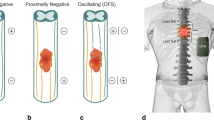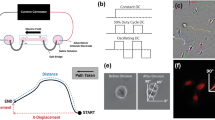Abstract
Applied electric fields (EFs) have previously been presented as a potential method of inducing functional recovery after neural trauma. To date, most of this research has focused on the application of a direct current (DC) stimulus to produce the desired EF and induce neuronal growth. We propose that high duty-cycle alternating current (AC) stimulation is capable of inducing similar EFs within the spinal cord and eliciting a neural response with the added benefits of increased field propagation and lower power consumption. Through ex vivo tissue testing of porcine spinal columns and Xenopus laevis cell cultures, 80% duty-cycle AC stimulation was compared to DC stimulation for efficacy in field generation and induction of neurite growth. Results from ex vivo measurement show that AC stimulation is capable of producing EFs of greater magnitudes over an increased distance in the spinal cord than DC stimulation at the same current magnitude. Furthermore, stimulation of Xenopus laevis neuronal cultures with 80% duty-cycle rectangular waves indicated a significant increase in neurite length as compared to non-stimulated controls and cathodal preference, growth that was statistically similar to DC-stimulated cells. These results suggest high duty-cycle stimulation modalities to be applicable and perhaps preferable to DC stimulation in electrically mediated neuronal therapies.








Similar content being viewed by others
References
Borgens, R. B., A. R. Blight, D. J. Murphy, and L. Stewart. Transected dorsal column axons within the guinea pig spinal cord regenerate in the presence of an applied electric field. J. Comp. Neurol. 250:168–180, 1986.
Borgens, R. B., J. P. Toombs, G. Breur, W. R. Widmer, D. Waters, A. M. Harbath, P. March, and L. G. Adams. An imposed oscillating electric field improves the recovery of function of neurologically complete paraplegic dogs. J. Neurotrauma 16:639–657, 1999.
Chin, L., and M. Sherar. Changes in the dielectric properties of rat prostate ex vivo at 915 MHz during heating. Int. J. Hyperth. 20:517–527, 2004.
Gabriel, S., R. W. Lau, and C. Gabriel. The dielectric properties of biological tissues: II. Measurements in the frequency range 10 Hz to 20 GHz. Phys. Med. Biol. 41:2251–2269, 1996.
Haemmerich, D., O. R. Ozkan, J. Z. Tsai, S. T. Staelin, S. Tungjitkusolmun, D. M. Mahvi, and J. G. Webster. Changes in electrical resistivity of swine liver after occlusion and postmortem. Med. Biol. Eng. Comput. 40:29–33, 2002.
Hinkle, L., C. D. McCaig, and K. R. Robinson. The direction of growth of differentiating neurons and myoblasts from frog embryos in an applied electric field. J. Physiol. 314:121–135, 1981.
Hotary, K. B., and K. R. Robinson. Endogenous electrical currents and the resultant voltage gradients in the chick embryo. Dev. Biol. 140:149–160, 1990.
Hotary, K. B., and K. R. Robinson. The neural tube of the Xenopus embryo maintains a potential difference across itself. Dev. Brain Res. 59:65–73, 1991.
Hotary, K. B., and K. R. Robinson. Evidence for a role of endogenous electrical fields in chick embryo development. Development 114:985–996, 1992.
Metcalf, M. E., and R. B. Borgens. Weak applied voltages interfere with amphibian morphogenesis and pattern. J. Exp. Zool. 268:322–338, 1994.
National Spinal Cord Injury Statistical Center (NSCISC). Spinal Cord Injury Facts and Figures at a Glance. Birmingham, AL: National Spinal Cord Injury Statistical Center, 2008.
Nieuwkoop, P. D., and J. Faber. Normal Table of Xenopus laevis (Daudin). New York: Garland Publishing, Inc., 1994.
Patel, N., and M. Poo. Orientation of neurite growth by extracellular electric fields. J. Neurosci. 2:483–496, 1982.
Patel, N. B., and M. Poo. Perturbation of the direction of neurite growth by pulsed and focal electric fields. J. Neurosci. 4:2939–2947, 1984.
Shapiro, S., R. Pascuzzi, K. Roos, M. Groff, S. Purvines, S. Hagy, and P. Nelson. Oscillating field stimulation for complete spinal cord injury in humans: a phase 1 trial. J. Neurosurg. Spine 2:3–10, 2005.
Shi, R., and R. B. Borgens. Three dimensional gradients of voltage during development of the nervous system as invisible coordinates for the establishment of the embryonic pattern. Dev. Dyn. 202:101–114, 1995.
Author information
Authors and Affiliations
Corresponding author
Additional information
Associate Editor Leonidas D Iasemidis oversaw the review of this article.
Rights and permissions
About this article
Cite this article
Graves, M.S., Hassell, T., Beier, B.L. et al. Electrically Mediated Neuronal Guidance with Applied Alternating Current Electric Fields. Ann Biomed Eng 39, 1759–1767 (2011). https://doi.org/10.1007/s10439-011-0259-8
Received:
Accepted:
Published:
Issue Date:
DOI: https://doi.org/10.1007/s10439-011-0259-8




